Rice Face Mask For Acne: Benefits, Uses
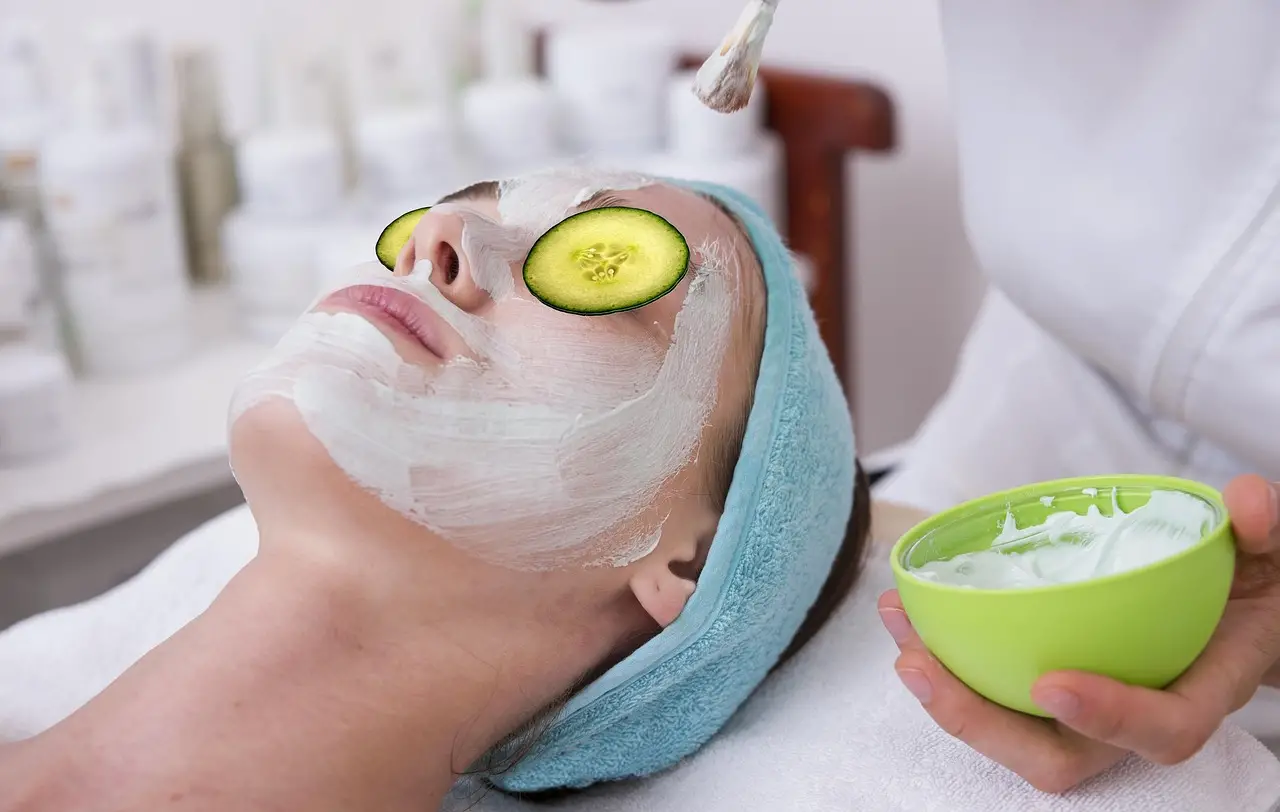
If you’re looking for a gentle yet powerful solution to acne, DIY rice face masks might be the answer. These masks are easy to prepare at home and can help clear blemishes, improve skin texture, and restore your skin’s natural glow.
Rice has long been a staple ingredient in skincare, especially in Asian beauty traditions, where it is revered for its skin-nourishing properties. For centuries, women in countries like Japan, Korea, and China have used rice water and rice-based treatments to maintain clear, youthful, and radiant skin.
Its natural ability to brighten, soothe, and hydrate the skin has made it a key component in many skincare routines.
For those with acne-prone skin, rice offers a range of benefits. It contains anti-inflammatory properties that help calm redness and irritation, while its oil-absorbing nature makes it excellent for controlling excess sebum.
Additionally, rice is packed with vitamins, minerals, and antioxidants that promote skin healing and repair, making it an effective natural remedy for breakouts and acne scars.
In this article, we’ll explore the different types of rice face masks you can make, their benefits, and how to use them for the best results.
Benefits of Rice for Acne-Prone Skin
Rice is a powerhouse ingredient for those struggling with acne. Its unique combination of oil-absorbing, anti-inflammatory, and skin-brightening properties makes it an excellent addition to a skincare routine. Here’s a detailed breakdown of how rice benefits acne-prone skin:
1. Absorbs Excess Oil – Helps Control Sebum Production
One of the main causes of acne is excessive sebum (oil) production, which clogs pores and leads to breakouts. Rice, especially rice flour and rice water, has natural oil-absorbing properties that help regulate sebum levels.
By keeping the skin balanced, rice prevents the formation of new acne while giving the skin a fresh, matte look. This is particularly beneficial for people with oily or combination skin types.
2. Soothes Inflammation – Reduces Redness and Irritation
Acne isn’t just about pimples—it often comes with redness, irritation, and inflammation. Rice contains anti-inflammatory compounds such as allantoin and ferulic acid, which help calm the skin.
Applying a rice face mask can reduce swelling and redness associated with active breakouts, making your skin appear more even-toned and less irritated.
3. Rich in Antioxidants – Fights Free Radicals That Cause Breakouts
Rice is packed with antioxidants, including ferulic acid, phytic acid, and vitamin E. These antioxidants fight free radicals—unstable molecules that can damage skin cells and accelerate acne formation.
By neutralizing these harmful molecules, rice helps protect the skin from environmental stressors, preventing breakouts and promoting a healthier complexion.
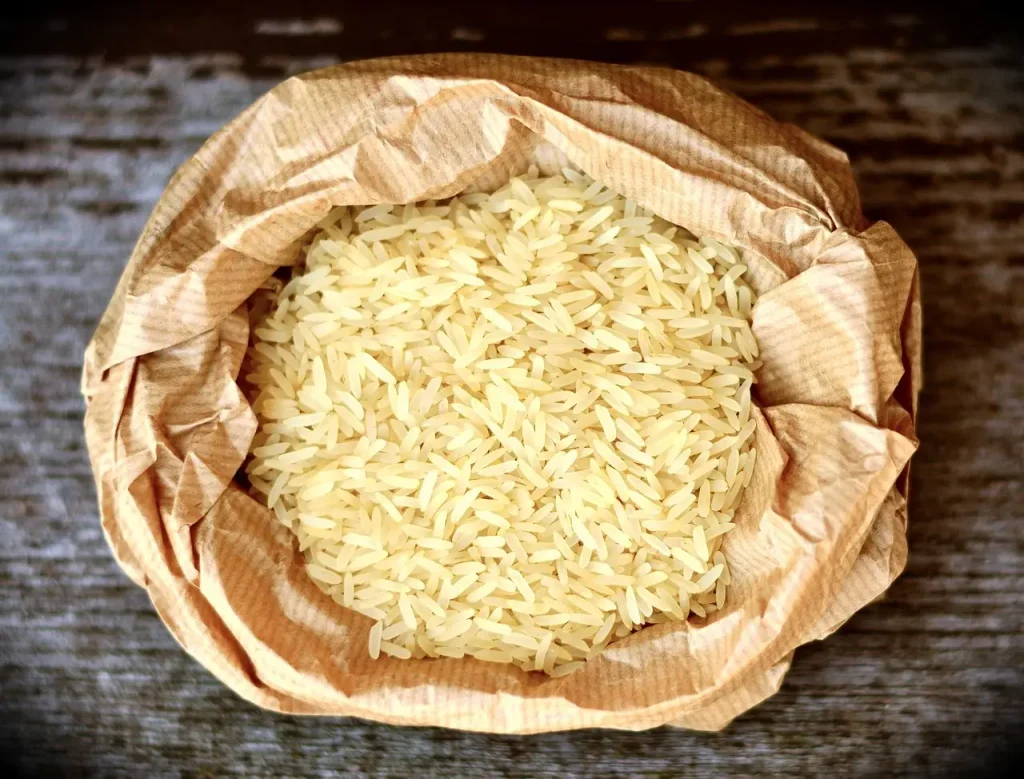
4. Natural Skin Brightener – Helps Fade Acne Scars and Hyperpigmentation
One of the most frustrating parts of dealing with acne is the lingering scars and dark spots it leaves behind. Rice contains natural skin-brightening agents, such as niacin (vitamin B3), which help even out skin tone and fade hyperpigmentation.
Regular use of rice-based treatments can gradually lighten acne scars and improve overall skin clarity, giving you a smoother and more radiant complexion.
5. Mild Exfoliation – Removes Dead Skin Cells and Unclogs Pores
A buildup of dead skin cells can clog pores, leading to blackheads, whiteheads, and acne flare-ups. Rice, when used as a scrub or mask, provides gentle exfoliation without being too harsh on the skin.
The fine texture of rice flour helps slough off dead skin cells, unclog pores, and promote skin renewal, reducing the chances of future breakouts. Unlike chemical exfoliants, rice offers a natural and non-irritating way to maintain clear skin.
With its ability to control oil, reduce inflammation, fight free radicals, brighten skin, and provide gentle exfoliation, rice is a fantastic ingredient for acne-prone skin. Incorporating rice into your skincare routine through DIY masks and treatments can help you achieve clearer, healthier skin naturally.
Different Forms of Rice Used in Face Masks
Rice can be incorporated into skincare in various forms, each offering unique benefits for acne-prone skin. Whether you need gentle exfoliation, hydration, nourishment, or extra moisture, there’s a rice-based ingredient that fits your needs. Here are the different forms of rice used in face masks and how they benefit the skin:
1. Rice Flour – Finely Ground Powder for Gentle Exfoliation
Rice flour is made by grinding raw rice into a fine powder. It is an excellent natural exfoliant that helps remove dead skin cells, unclog pores, and control excess oil production.
Unlike harsh physical scrubs, rice flour has a soft texture that provides gentle exfoliation without causing microtears in the skin. This makes it perfect for people with sensitive or acne-prone skin who need a mild yet effective way to keep their pores clear.
Benefits of Rice Flour:
- Absorbs excess oil, preventing breakouts
- Provides gentle exfoliation, removing dead skin cells
- Brightens the skin and fades acne scars
- Helps in reducing inflammation and redness
How to Use:
- Mix rice flour with honey, yogurt, or aloe vera gel to create a soothing face mask.
- Combine with water or rose water to make a simple exfoliating paste.
2. Rice Water – Fermented or Plain for Hydration and Toning
Rice water is the starchy liquid left after rinsing or boiling rice. It is rich in amino acids, vitamins, and minerals that nourish the skin and provide hydration.
Fermented rice water, in particular, contains beneficial enzymes and antioxidants that promote skin healing and balance the skin’s pH.
Benefits of Rice Water:
- Hydrates and soothes the skin
- Reduces redness and irritation caused by acne
- Helps tighten pores and control sebum production
- Improves skin texture and elasticity
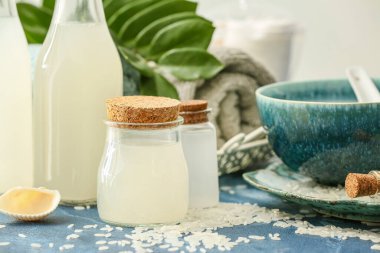
How to Use:
- Soak rice in water for 30 minutes, strain the liquid, and use it as a toner.
- Store fermented rice water in a spray bottle and mist it on your face for a refreshing boost.
3. Cooked Rice – Soft and Soothing for a Nourishing Mask
Cooked rice is an underrated but effective skincare ingredient. When mashed into a paste, it forms a thick, hydrating mask that provides deep nourishment and soothes irritated skin.
The starch and vitamins in cooked rice help to calm inflammation, making it ideal for those dealing with active breakouts or dry patches.
Benefits of Cooked Rice:
- Provides deep hydration and nourishment
- Soothes inflamed and irritated skin
- Softens rough texture and brightens complexion
- Helps repair and rejuvenate the skin
How to Use:
- Mash cooked rice and mix it with milk, honey, or yogurt to create a rich, creamy mask.
- Apply a thin layer of the rice paste on your skin, leave it on for 15–20 minutes, and rinse off with lukewarm water.
4. Rice Bran Oil – Lightweight, Non-Comedogenic Oil for Added Moisture
Rice bran oil is extracted from the outer layer of rice grains. It is a lightweight oil packed with antioxidants, vitamin E, and essential fatty acids that provide hydration without clogging pores.
Since it is non-comedogenic (meaning it won’t block pores), it is a great option for acne-prone skin that still needs moisture.
Benefits of Rice Bran Oil:
- Provides lightweight hydration without making the skin greasy
- Rich in antioxidants that protect against free radicals
- Helps reduce acne scars and hyperpigmentation
- Supports skin barrier function, making skin more resilient
How to Use:
- Apply a few drops of rice bran oil as the last step in your skincare routine for added moisture.
- Mix it with rice flour or cooked rice to enhance your DIY face mask.
Each form of rice offers unique benefits for acne-prone skin, whether you need exfoliation, hydration, or nourishment. You can choose rice flour for gentle scrubbing, rice water for hydration, cooked rice for soothing care, or rice bran oil for a moisture boost. In the next section, we’ll explore easy DIY rice face mask recipes to help you achieve clear, glowing skin naturally.
DIY Rice Face Mask Recipes for Acne
Using rice in homemade face masks is an easy and effective way to treat acne while nourishing your skin. Below is a soothing and antibacterial rice face mask recipe that helps reduce breakouts, calm inflammation, and fade acne scars.
1. Rice Flour & Honey Mask (Soothing & Anti-Bacterial)
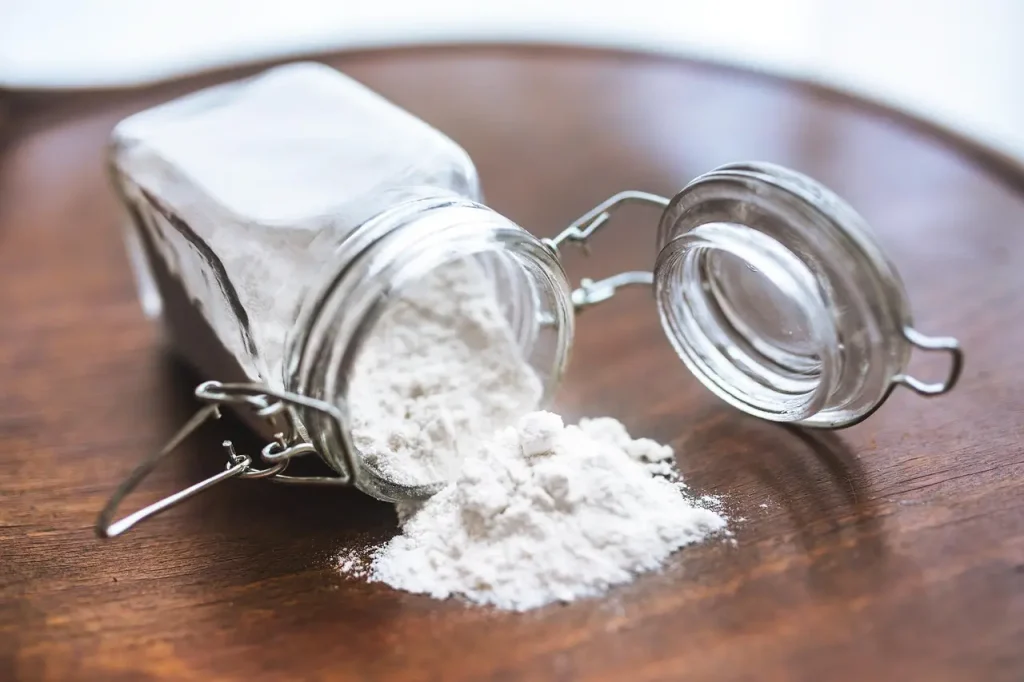
Ingredients:
- 2 tablespoons of rice flour
- 1 tablespoon of raw honey
- A few drops of fresh lemon juice (optional)
Instructions:
- In a small bowl, mix the rice flour and honey until you get a smooth paste.
- Add a few drops of lemon juice for extra brightening and antibacterial benefits.
- Apply the mixture evenly to clean, dry skin, avoiding the eye area.
- Leave it on for 15 minutes or until it starts to dry.
- Gently rinse off with lukewarm water, using circular motions to exfoliate.
- Pat your skin dry and follow up with a lightweight moisturizer.
Benefits:
- Kills bacteria: Honey has natural antibacterial properties that help fight acne-causing bacteria.
- Calms inflammation: Rice flour and honey work together to soothe redness and irritation.
- Lightens scars: Lemon juice and rice flour help brighten the skin and fade acne scars over time.
This mask is ideal for those dealing with inflamed acne and post-acne marks. Use it 2–3 times a week for the best results.
2. Rice Water & Aloe Vera Mask (Hydrating & Healing)
Ingredients:
- 3 tablespoons of fermented rice water
- 1 tablespoon of fresh aloe vera gel
Instructions:
- In a small bowl, mix the fermented rice water and aloe vera gel until well combined.
- Soak a cotton pad in the mixture and gently apply it to clean skin.
- Leave it on for 10 minutes, allowing the skin to absorb the nutrients.
- Rinse off with cool water and pat your skin dry.
- Follow up with a lightweight moisturizer to lock in hydration.
Benefits:
- Soothes redness: Aloe vera’s anti-inflammatory properties calm irritated and inflamed skin.
- Speeds up healing: Rice water contains amino acids and antioxidants that promote skin repair.
- Hydrates: Both aloe vera and rice water provide deep hydration without making the skin greasy.
This mask is perfect for sensitive, acne-prone skin that needs extra care. It can be used daily as a gentle toner or 2–3 times a week as a hydrating treatment.
3. Cooked Rice & Yogurt Mask (Brightening & Exfoliating)
Ingredients:
- 2 tablespoons of mashed cooked rice
- 1 tablespoon of plain yogurt
- ½ teaspoon of turmeric powder
Instructions:
- Mash the cooked rice until it forms a smooth paste.
- Add the yogurt and turmeric, mixing well to create a thick, creamy consistency.
- Apply the mixture evenly to clean skin, avoiding the eye area.
- Leave it on for 15–20 minutes to allow the nutrients to absorb.
- Rinse off with lukewarm water, gently massaging in circular motions for mild exfoliation.
- Pat your skin dry and follow up with a moisturizer.
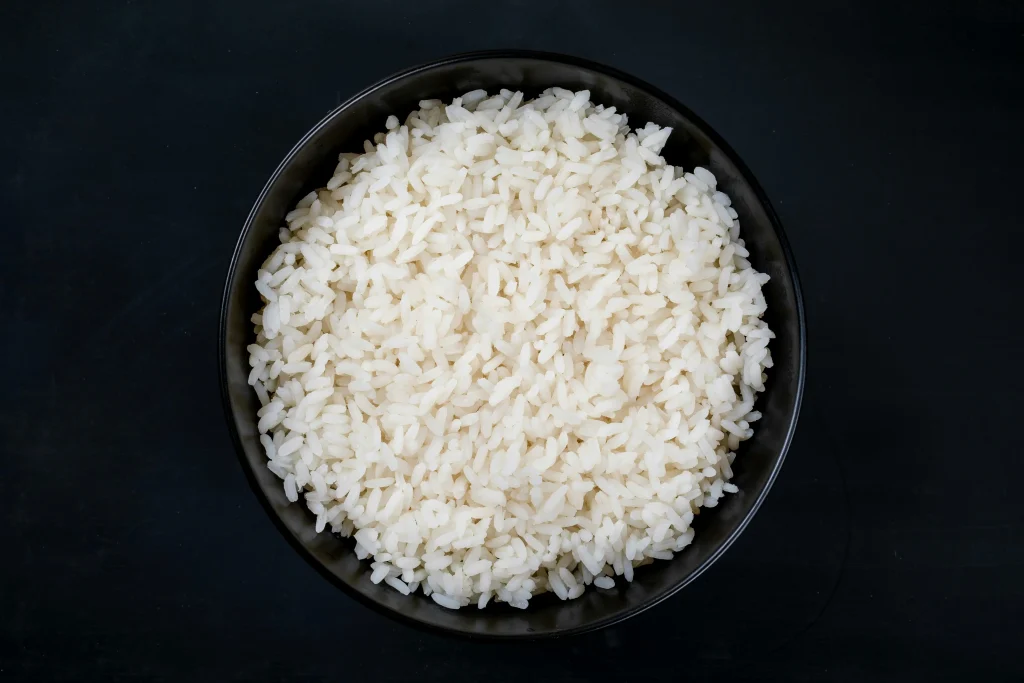
Benefits:
- Removes dead skin cells: The soft texture of mashed rice gently exfoliates the skin, unclogging pores.
- Brightens scars: Turmeric and yogurt help fade acne scars and even out skin tone.
- Nourishes: Yogurt is rich in lactic acid and probiotics, which promote a healthy skin barrier.
This mask is ideal for dull, acne-prone skin that needs both exfoliation and nourishment. Use it 2–3 times a week for a brighter, smoother complexion.
4. Rice Flour & Green Tea Mask (Oil-Control & Detoxifying)
Ingredients:
- 2 tablespoons of rice flour
- 3 tablespoons of freshly brewed green tea (cooled)
- 2–3 drops of tea tree oil
Instructions:
- In a small bowl, mix the rice flour with green tea until it forms a smooth paste.
- Add a few drops of tea tree oil and stir well.
- Apply the mixture evenly to clean skin, avoiding the eye area.
- Leave it on for 15 minutes, allowing it to absorb excess oil and impurities.
- Rinse off with lukewarm water, gently massaging to exfoliate.
- Pat your skin dry and apply a lightweight, non-comedogenic moisturizer.
Benefits:
- Controls excess oil: Rice flour absorbs sebum, preventing clogged pores.
- Fights acne bacteria: Tea tree oil has antibacterial properties that help reduce breakouts.
- Soothes: Green tea’s anti-inflammatory compounds calm redness and irritation.
This mask is perfect for oily, acne-prone skin and can be used 2–3 times a week to keep breakouts under control.
How to Use Rice Face Masks Effectively
To get the best results from rice-based face masks, it’s essential to use them correctly. Here are some key tips to ensure your skin benefits from these natural treatments without irritation.
1. Best Time to Apply
Applying a rice face mask in the evening allows your skin to absorb its nutrients without interference from makeup, sun exposure, or pollution. Nighttime is also when the skin repairs itself, making it the ideal time for a soothing and nourishing mask.
Tip: If using a mask with turmeric or lemon juice, applying it at night helps avoid sun sensitivity during the day.
2. Frequency

While rice masks are gentle, over-exfoliating or using them too frequently can disrupt your skin’s natural barrier. Stick to 2–3 times per week to see improvements in acne, oil control, and overall skin texture without causing dryness or irritation.
Tip: If you have very sensitive skin, start with once a week and gradually increase usage based on how your skin reacts.
3. Patch Test
Even though rice is generally safe for all skin types, combining it with other ingredients (like lemon juice or tea tree oil) can cause sensitivity in some people. Always do a patch test before applying a new mask to your entire face.
How to Patch Test:
- Apply a small amount of the mask to your inner wrist or behind your ear.
- Wait 24 hours to see if any irritation, redness, or itching occurs.
- If there’s no reaction, it’s safe to use on your face.
4. Moisturize After Use
After rinsing off a rice face mask, it’s important to follow up with a hydrating moisturizer to prevent dryness and keep your skin balanced. Even masks designed to control oil can strip away some natural moisture, so replenishing hydration is key.
Tip: If your skin feels extra dry, use a lightweight, non-comedogenic facial oil like rice bran oil or aloe vera gel to lock in hydration.
Using rice face masks the right way can help you achieve clearer, brighter, and healthier skin without the risk of irritation. By applying them in the evening, using them moderately, patch-testing new ingredients, and moisturizing afterward, you’ll maximize their benefits while keeping your skin barrier strong.
Additional Skincare Tips for Acne-Prone Skin
While rice face masks can help manage acne, achieving clear and healthy skin requires a well-rounded skincare routine and healthy lifestyle choices. Here are some essential tips to keep your skin balanced and prevent breakouts.
1. Use a Gentle Cleanser to Avoid Stripping Natural Oils
Cleansing is the foundation of any skincare routine, but harsh cleansers can strip the skin of its natural oils, leading to overproduction of sebum and more breakouts. Choose a mild, sulfate-free cleanser that removes dirt and excess oil without disrupting the skin barrier.
Tip: Look for ingredients like ceramides, hyaluronic acid, and niacinamide in cleansers to keep the skin hydrated and calm.
2. Apply Non-Comedogenic Moisturizers to Keep Skin Balanced
Many people with acne-prone skin avoid moisturizers, fearing they will make their skin oilier. However, skipping moisturizer can cause dehydration, prompting your skin to produce more oil to compensate. Choose a lightweight, non-comedogenic moisturizer to maintain hydration without clogging pores.
Best Moisturizers for Acne-Prone Skin:
- Gel-based or water-based moisturizers
- Ingredients like aloe vera, green tea extract, and hyaluronic acid
- Oil-free formulas that won’t trigger breakouts
3. Drink Plenty of Water to Flush Out Toxins

Staying hydrated helps your body flush out toxins and keeps your skin clear. Water aids in digestion, improves circulation, and prevents the buildup of toxins that can contribute to acne.
Tip: Aim for at least 8 glasses of water daily, and incorporate hydrating foods like cucumbers, watermelon, and leafy greens into your diet.
4. Maintain a Healthy Diet with Less Sugar and Dairy
What you eat can significantly impact your skin. High sugar intake and dairy consumption have been linked to increased acne breakouts due to their effects on insulin levels and inflammation.
Diet Tips for Clearer Skin:
- Reduce processed sugars and refined carbs to prevent insulin spikes.
- Limit dairy products, especially cow’s milk, which may trigger hormonal acne.
- Eat antioxidant-rich foods like berries, green tea, and dark leafy vegetables.
- Include omega-3 fatty acids (found in salmon, flaxseeds, and walnuts) to reduce inflammation.
Taking care of acne-prone skin goes beyond using masks—it requires a gentle skincare routine, proper hydration, and a balanced diet. By following these tips, you can enhance the effects of your rice face masks and achieve long-term skin health.
Conclusion
Rice face masks are a simple yet effective way to manage acne, control excess oil, and improve overall skin health. Whether you use rice flour for gentle exfoliation, rice water for hydration, or cooked rice for nourishment, these natural ingredients can help soothe inflammation, fight acne-causing bacteria, and fade scars over time.
By incorporating these DIY rice face masks into your skincare routine 2–3 times a week, you can achieve clearer, brighter, and healthier skin without relying on harsh chemicals. Don’t forget to pair them with a gentle cleanser, non-comedogenic moisturizer, and a healthy diet for the best results!
Now it’s your turn! Which rice face mask will you try first? Let me know in the comments, and feel free to share your experiences or ask any questions—I’d love to hear from you!
Such amazing info and thank you for the recipes. My son & I experiment with homemade products all will defintely ne trying these
Homemade products are the best! Make sure to pick a recipe that suits your skin type.